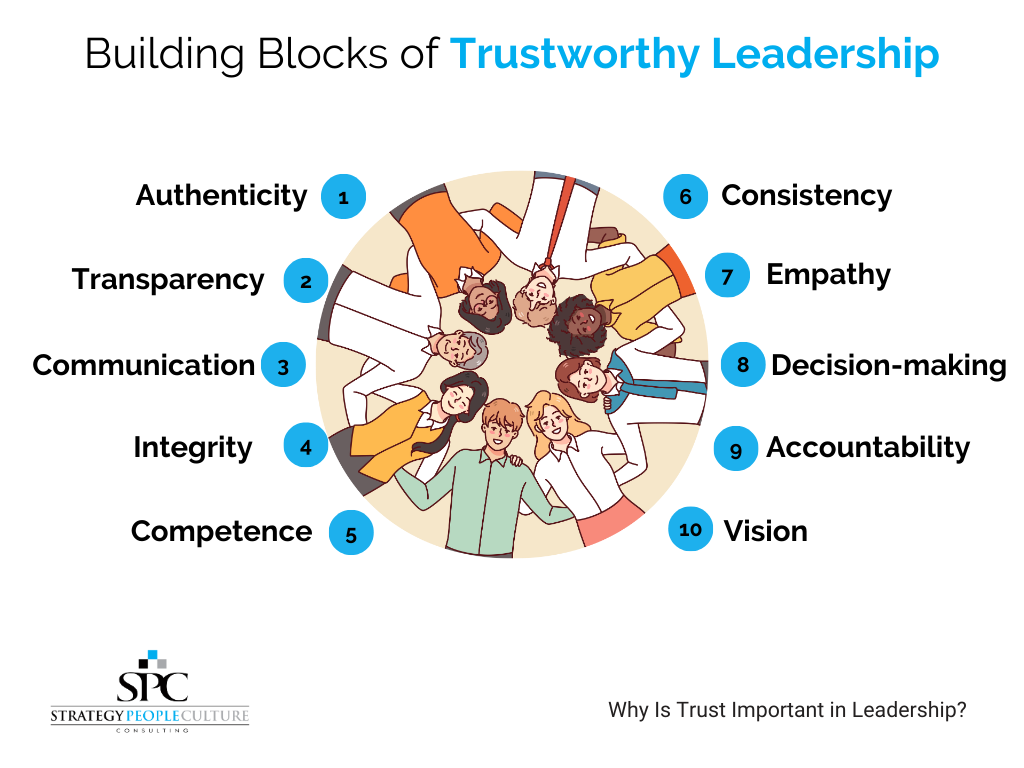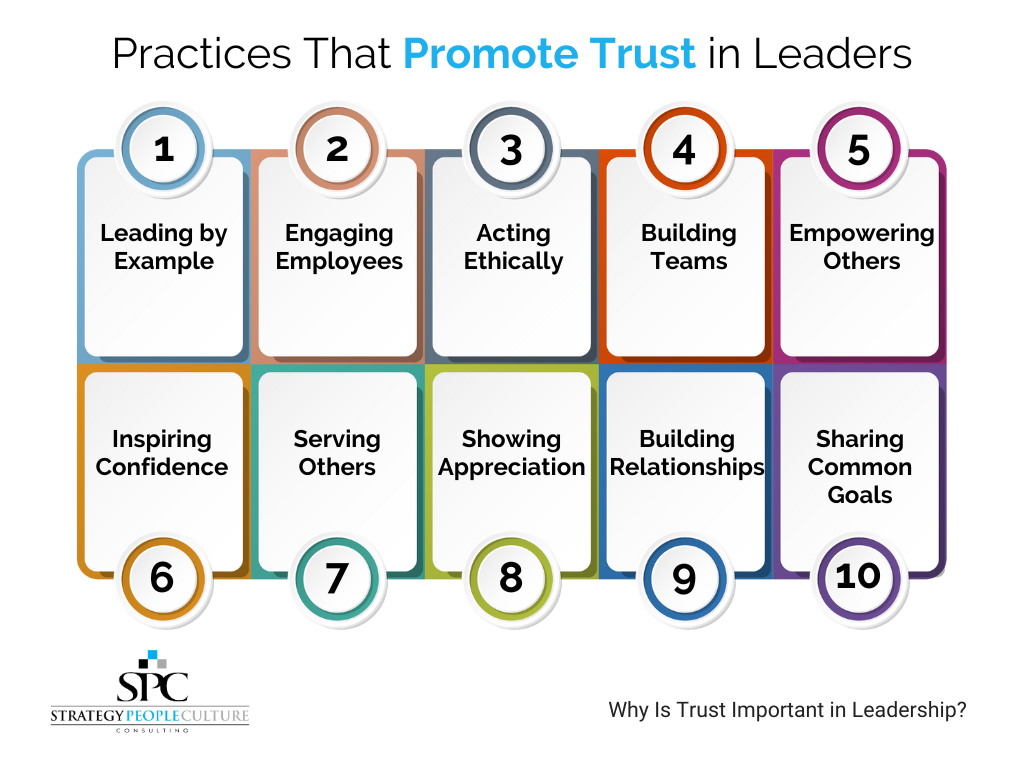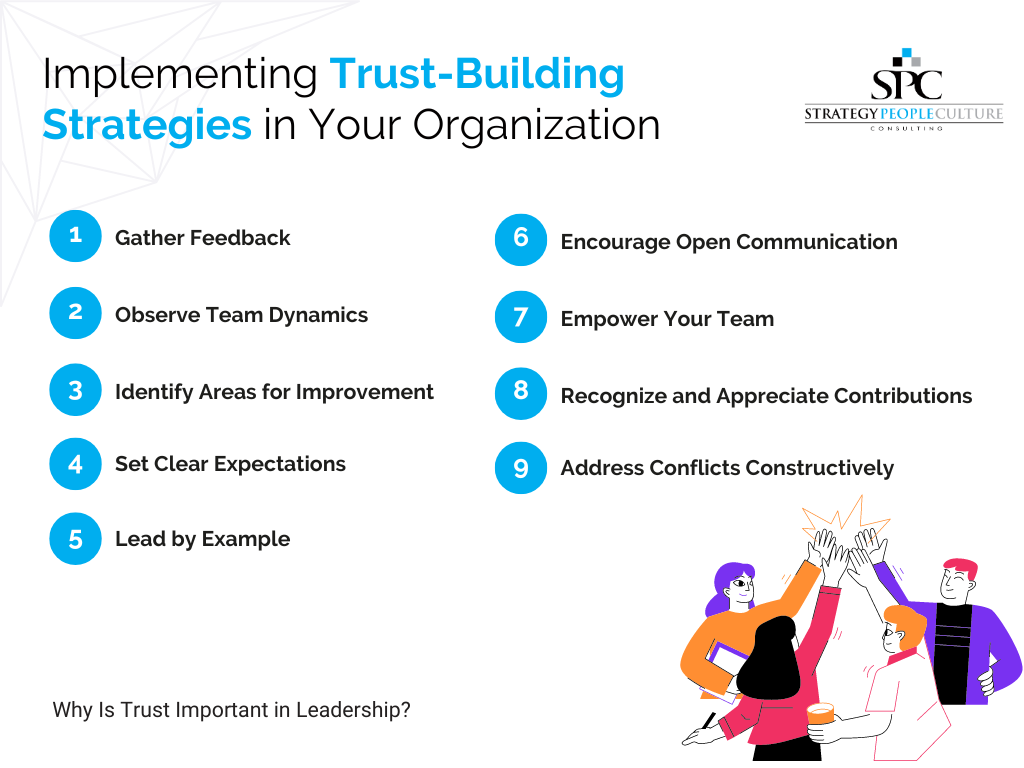Why Is Trust Important in Leadership?

Building Trust Within Your Team: The Cornerstone of High-Performance Leadership
Trust is the bedrock of any successful team. For leaders aiming to inspire, motivate, and drive exceptional performance, understanding how to cultivate and maintain trust is crucial. This applies to all organizations, from the military to volunteers, to for-profit and not-for-profit organizations alike. In today’s fast-paced business environment, trust isn’t just a nice-to-have; it’s a fundamental pillar that dramatically impacts an organization’s effectiveness and resilience. In fact, leadership trust is the highest-ranked motivator of employee engagement, with 77% of employees citing it as the most important factor, surpassing even organizational culture (73%) and opportunities for career growth (66%).

As an executive coach, I have guided leaders in embedding trust within their teams, creating a foundation for sustainable success. In this article, we explore the vital role trust plays in leadership and offer actionable strategies to help you foster trust within your team.
The Essence of Trust in the Workplace
Trust is the glue that binds individuals within an organization, creating a sense of safety and belonging. It goes beyond simply believing in someone’s ability; it involves confidence in their character and intentions. In modern workplaces, where collaboration and innovation are key, trust forms the foundation for meaningful relationships and effective teamwork. When employees feel trusted, they are more likely to take initiative, share ideas, and commit fully to their roles.
Leadership as the Foundation of Trust
Leaders play a pivotal role in establishing and nurturing trust within their teams. But how do leaders turn trust into tangible results? Consider these scenarios:
- “The Turnaround”: What would happen if a disengaged and underperforming team were given the tools to rebuild trust? Imagine the impact of targeted trust-building initiatives that transform such a team into a cohesive, high-performing unit. How can a leader spark this transformation within their own organization?
- “The Innovation Catalyst”: How might prioritizing trust and empowerment unlock your team’s creative potential? Picture a leader who makes trust a cornerstone of their leadership approach, leading to a surge in innovation and breakthrough ideas. What steps could you take to cultivate a similar environment of trust and creativity?
- “The Conflict Resolution”: What strategies would help a team mired in conflict rebuild trust and collaboration? Consider the power of executive coaching combined with trust-building strategies that help a team overcome internal divisions. How can you apply these strategies to resolve conflicts and strengthen trust within your team?
These scenarios illustrate how trust is not just a leadership ideal but a practical tool that drives performance, innovation, and collaboration. By asking yourself these questions, you may begin to explore the potential of trust within your own leadership and how it can be a catalyst for significant change.
Building Blocks of Trustworthy Leadership
Trust is not just an abstract concept; it’s cultivated through deliberate actions and behaviors that align with core principles. Strategy People Culture’s C.A.R.E.™ Tenets—Conviction, Adaptability & Accountability, Realness, and Enthusiasm—serve as guiding pillars for leaders to build and sustain trust within their teams. By integrating these tenets with the building blocks of trustworthy leadership, leaders can create a supportive and thriving work environment that fosters collaboration, growth, and success. Below are a few of these more well-known actions and behaviors:

- Authenticity: True leadership begins with being genuine. Authentic leaders connect with their teams on a deeper level by being true to their values and transparent in their intentions.
- Transparency: Openness and clarity are vital for cultivating trust. By embracing transparency, leaders create an environment where trust can grow, allowing for verification and scrutiny to ensure that trust is earned and maintained.
- Communication: The foundation of trust lies in effective communication. By fostering clear and open dialogue, leaders ensure that their teams are aligned and understand the collective goals.
- Integrity: Trust is solidified when leaders consistently follow through on their promises. Integrity means aligning actions with words and reinforcing team members’ trust in their leader.
- Competence: Demonstrating expertise and skill builds confidence among team members. When leaders showcase their competence, they reassure the team that their decisions are well-informed and sound.
- Consistency: Predictable actions and decisions foster a stable and trusting environment. Consistency in leadership helps build a reliable framework within which teams can operate.
- Empathy: Understanding and sharing the emotions of team members is key to creating a supportive atmosphere. Leaders who show empathy build trust by recognizing and addressing their employees’ needs and feelings.
- Decision-making: Timely and fair decisions demonstrate a leader’s commitment to the well-being of both the team and the organization. Thoughtful decision-making builds trust by showing that leaders value their people and the success of the group.
- Accountability: Taking responsibility for outcomes and being open to scrutiny shows a leader’s commitment to integrity and continuous improvement. Accountability reinforces trust by ensuring that leaders are answerable for their actions.
- Vision: A clear and shared vision aligns the team toward common goals, fostering collective trust. By articulating a path forward, leaders help their teams see the bigger picture and work together in pursuit of shared success.
These building blocks of trustworthy leadership, when practiced in alignment with the C.A.R.E.™ Tenets, create a robust framework for leading with purpose, integrity, and respect while inspiring your team to achieve collective success.
Practices That Promote Trust in Leaders

- Leading by Example: Demonstrate the behaviors you wish to see in others, setting a positive standard for the team.
- Engaging Employees: Involve employees in decision-making to show that their opinions are valued.
- Acting Ethically: Uphold strong moral principles to build trust through consistency and fairness.
- Building Teams: Foster collaboration and create a sense of belonging within the team.
- Empowering Others: Encourage autonomy while providing the necessary support to succeed.
- Inspiring Confidence: Communicate a clear and compelling vision that motivates and reassures your team.
- Serving Others: Prioritize the needs of employees and the organization to build trust through selfless leadership.
- Showing Appreciation: Regularly recognize and value the contributions of your team members.
- Building Relationships: Cultivate positive connections within and outside the team to strengthen trust.
- Sharing Common Goals: Align your team around shared values and objectives to reinforce a sense of unity and trust.
How to Apply Trust-Building Strategies in Leadership
These real-world examples show how leaders who prioritize trust can overcome challenges and drive remarkable outcomes. Let’s explore how these scenarios unfolded and consider practical steps you can take to achieve similar results.
The Turnaround: In this case, a client faced a disengaged and underperforming team. Through trust-building initiatives like open forums for feedback and regular check-ins, the team was gradually transformed into a cohesive and high-performing unit.

Action steps to consider: Start by conducting a survey to gauge current levels of trust and engagement within your team. Follow this with regular, structured team meetings focused on transparency and shared goals. Really important to consider before asking for feedback is to do a self-assessment on your and the organization’s readiness to listen and address the feedback.
Example activities: Implement “pulse check” surveys to gather ongoing feedback and hold monthly trust-building workshops to address specific concerns and develop stronger team bonds.
The Innovation Catalyst: A leader who made trust and empowerment a priority saw a remarkable increase in innovation and creative output within their team. By fostering an environment where team members felt safe to share ideas and take risks, the leader unlocked the team’s creative potential.

Action steps to consider: Encourage a culture of experimentation by rewarding innovative ideas and supporting calculated risks.
Example activities: Create an “innovation incubator” where team members can pitch and develop ideas without fear of failure. Regularly celebrate creative successes, no matter how small, to build confidence and trust.
The Conflict Resolution: In this scenario, a team struggling with internal conflict and mistrust was able to rebuild relationships and enhance collaboration through targeted trust-building strategies. Executive coaching played a key role in helping the team identify and address underlying issues, leading to a more harmonious and productive environment.

Action steps to consider: An executive coach will create a program to engage and facilitate conflict resolution and trust-building sessions. The focus is on identifying the root causes of conflicts and developing a shared vision moving forward.
Example activities: Conduct “trust circles” where team members can openly discuss issues in a safe, mediated environment. Establish a conflict resolution framework that encourages constructive dialogue and mutual respect.
Each of these examples underscores the transformative power of trust in leadership. By implementing similar strategies, you can drive significant improvements in team performance, creativity, and collaboration.
Implementing Trust-Building Strategies in Your Organization

- Gather Feedback: Use surveys or interviews to gauge employees’ perceptions of trust within your organization.
- Observe Team Dynamics: Watch how your team members interact, looking for signs of trust or mistrust.
- Identify Areas for Improvement: Pinpoint specific areas where trust is lacking or could be strengthened.
- Set Clear Expectations: Communicate the importance of trust, accountability, and the role of verification in maintaining a trusting environment.
- Lead by Example: Model honesty, transparency, and respect to set a standard for your team.
- Encourage Open Communication: Create a safe space for sharing ideas and concerns without fear of reprisal.
- Empower Your Team: Delegate responsibility while ensuring systems are in place to verify progress and outcomes.
- Recognize and Appreciate Contributions: Celebrate individual and team successes to reinforce a culture of trust.
- Address Conflicts Constructively: Handle disagreements promptly and fairly, focusing on solutions rather than blame.
Sustaining Trust in Leadership

Maintaining trust within a team isn’t a one-time effort or a product of organizational effort as described in some of the concepts above; it’s an ongoing process that requires consistent attention and care. As a leader, it’s essential to recognize that trust can be fragile, especially when faced with challenges or setbacks. To sustain trust, leaders must uphold mutual accountability and ensure that their actions consistently align with the organization’s values. This means not just talking the talk but also walking the walk—showing through your actions that trust and integrity are non-negotiable principles. One of the most difficult leadership behaviors a leader has is to routinely and honestly look inwardly at themselves, challenge their own behaviors and thought processes, and explore other possibilities on how they themselves can better create trust and advance the organization.
When trust is tested, whether by internal conflicts, external pressures, or mistakes, it’s crucial to have a strategy in place to restore it. Open communication and transparency become even more vital in these moments. By addressing issues head-on, acknowledging missteps, and taking corrective actions, leaders can demonstrate their commitment to rebuilding and maintaining trust. This approach not only mends any rifts but also strengthens the team’s resilience.
Building trust is not a one-off task; it’s a continuous cycle of effort and learning. As your organization evolves, so too should your strategies for nurturing trust. Regularly revisiting and refining your approach ensures that trust remains a cornerstone of your leadership and organizational culture, even in the face of inevitable challenges.
Conclusion
Trust is the cornerstone of high-performance leadership, driving engagement, collaboration, and success. Leaders who prioritize trust create environments where teams thrive, innovation flourishes, and results are achieved. As you continue your leadership journey, remember that trust is not a one-time achievement but an ongoing commitment. By investing in trust-building, you lay the foundation for sustained success and a thriving organizational culture.
Ready to build a high-trust, high-performing team? Partner with Strategy People Culture today! Through our executive coaching programs, we equip leaders with the tools and strategies to cultivate trust, enhance collaboration, and achieve extraordinary results. Contact us today for a complimentary consultation.
